Refreshing and irresistible, raitas are an Indian yogurt-based dip that is served with biryani, pulao, or any gravy or non-gravy Indian dishes. If you're a big fan of spicy Indian food, you want raita in your repertoire as this baby will extinguish the fire in your mouth like no other! This Easy Everyday Raita Recipe for Biryani will go really well with all your favorite Indian dishes, not just biryanis.
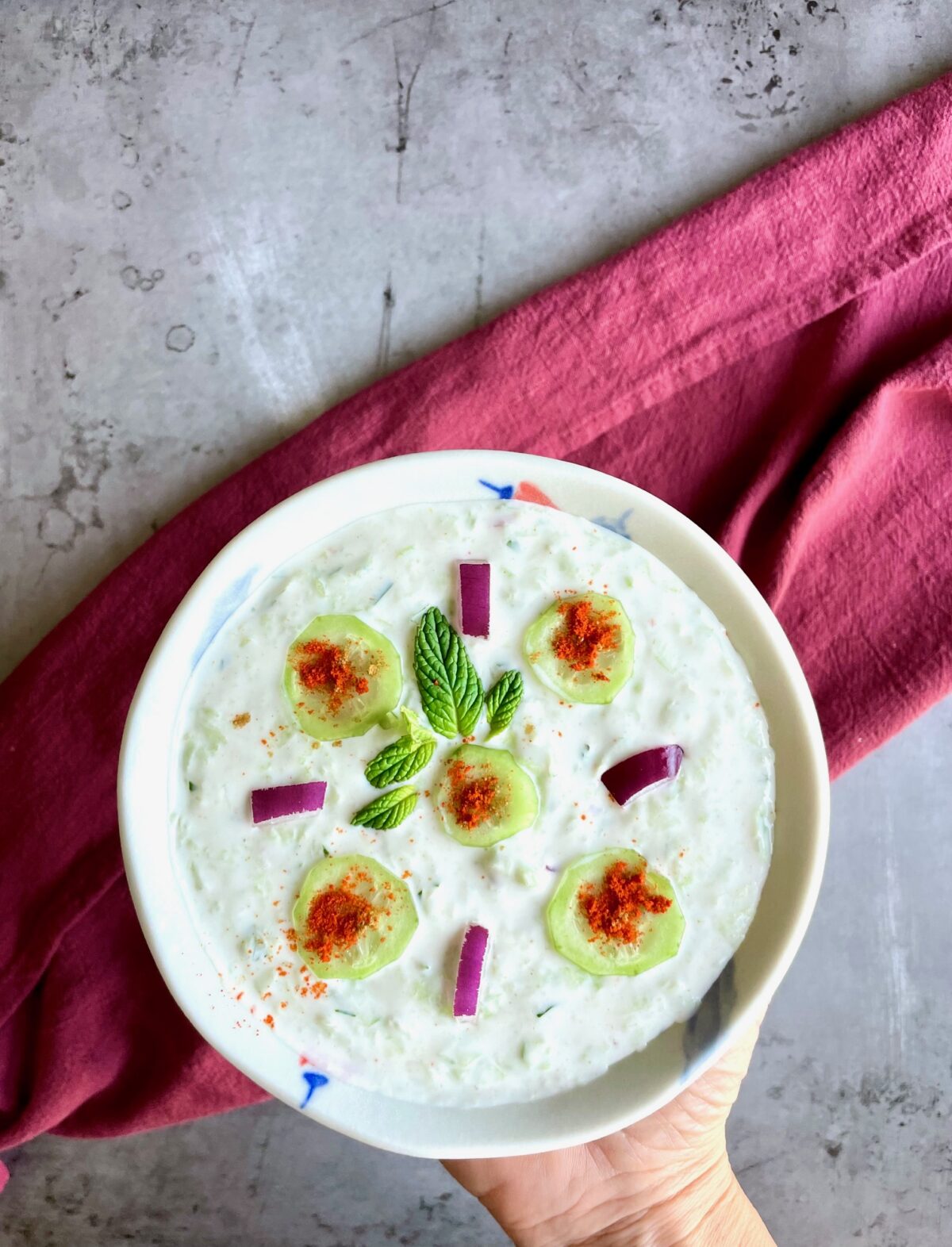
Jump to:
- What is raita for biryani and what is it made of?
- Types of raitas
- My raita version
- Health benefits of raita
- Why you'll love this raita recipe
- Recipe Ingredients
- Ingredient Notes
- How to make this raita recipe for biryani step by step
- Frequently Asked Questions (FAQs)
- Sourcing unusual ingredients
- Easy Everyday Raita Recipe for Biryani (Without Sugar)
What is raita for biryani and what is it made of?
Traditional raita is a very simple yogurt condiment that accompanies almost all Indian meals, but is more frequently associated with biryanis. It can be compared to Greek tzatziki, although the flavor profile is different. Raita most commonly consists of a combination of fresh yogurt, vegetables, fresh herbs, along with spices. At its most basic, raita contains only 5 ingredients: thick fresh curd or dahi, cucumber, red onion, fresh cilantro, and cumin. A basic raita is sometimes called cucumber raita and this is the most common type of raita you'll find in restaurants in the West.
Types of raitas
Although raita is most commonly associated with India, other South Asian countries like Pakistan, Nepal, Bangladesh, and Sri Lanka have also made it a key component in their respective cuisines. There are as many variations of this delicious yogurt dip as there are spicy curries and biryanis across the Indian subcontinent. It goes well with everything from vegetarian biryani to Malabar biryani, chicken curry, and all types of gravy and non-gravy Indian dishes. Below is just a sample of the types of dahi raitas that are popular across Hindustan.
Northern Indian raita
The Northern part of India is cooler than tropical Southern India. So it take full advantage of its winter carrots, along with summer cucumbers and other fresh vegetables to create its typical vegetable raita. It's whisked with a pinch of toasted cumin powder and red chili powder.
That region also boasts an abundance of anti-oxidant-rich pomegranates, hence the birth of the visually striking bejeweled raita. The edible pomegranate seeds are naturally sweet and tangy and this flavor profile marries well with raita.
Northern India is also home to one of my very favorite Indian "spices": black salt. Also known as kala namak, black salt is actually pinkish in color and contains trace amounts of sulfur compounds that give this aged salt an intoxicating aroma, coveted in Indian cuisine. This unique salt is often added to raitas in that part of India.
South Indian raita
South India is close to the equator and that means it is very hot and humid! This type of weather condition is ideal for growing tropical fruits, vegetables, and herbs like young fresh coconuts, chilies, and curry leaves! Consequently, South Indian raitas, also known as pachadi (roughly stands for unripe veggies or fruits), tend to feature these tropical ingredients. Having said that, the most basic type of South Indian raita is the humble onion raita.
Boondi raita, or raita with deep-fried chickpea balls
The first time I had boondi raita was at a Rajasthani restaurant called Bhookhe in Artesia, LA County's Little India (see picture below). I have to admit that although I'm very familiar with the intricacies of Indian cuisine, I'd somehow never seen such a raita! I was very intrigued by it. Boondi means "drop" in Hindi. So Boondi are small deep-fried chickpea flour balls and they can be either sweet or salty. Bondi raita is more popular in the Northern parts of India and it complements their rich dishes very well.
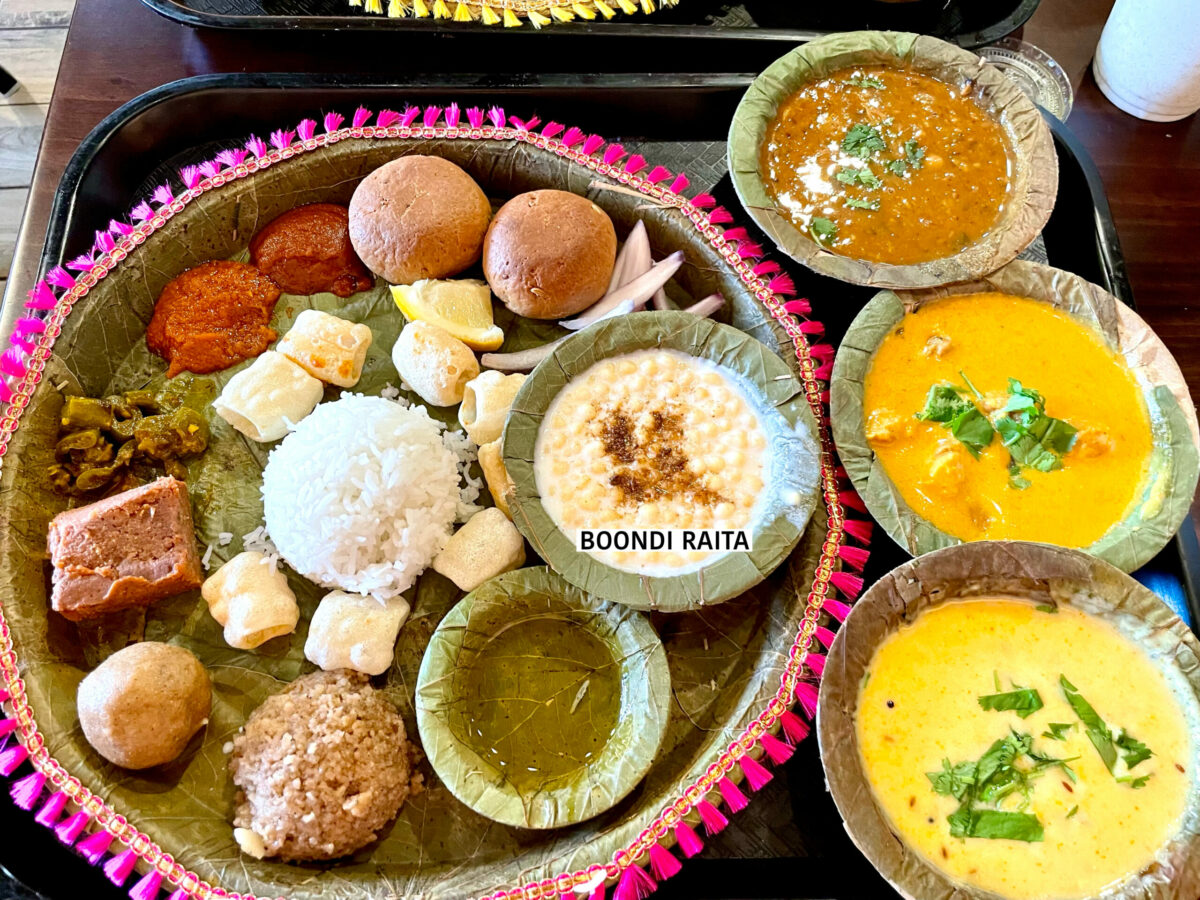
My raita version
This is my go-to everyday raita recipe for biryani (and many other Indian dishes). I've settled on this simple raita recipe after trying others and refining some of the elements. But don't be fooled by its simplicity because it will make your dishes shine!
Although I'm not vegan, I'm very sensitive to lactose, so whenever I can substitute a dairy product for a plant-based counterpart without sacrificing the taste of the end product, I do it. This is the case with this Indian raita. However, if your personal preference is to use regular yogurt, you can simply substitute it for vegan yogurt.
As I'm prediabetic, I avoid any type of added sugar whenever I can. This is why this recipe doesn't contain any added sugar of any type. But if you like a little sweetness in your raita, you can add a pinch of sugar. Think of my version as extra healthy!
For the ingredients, scroll down to the Recipe Ingredients section.
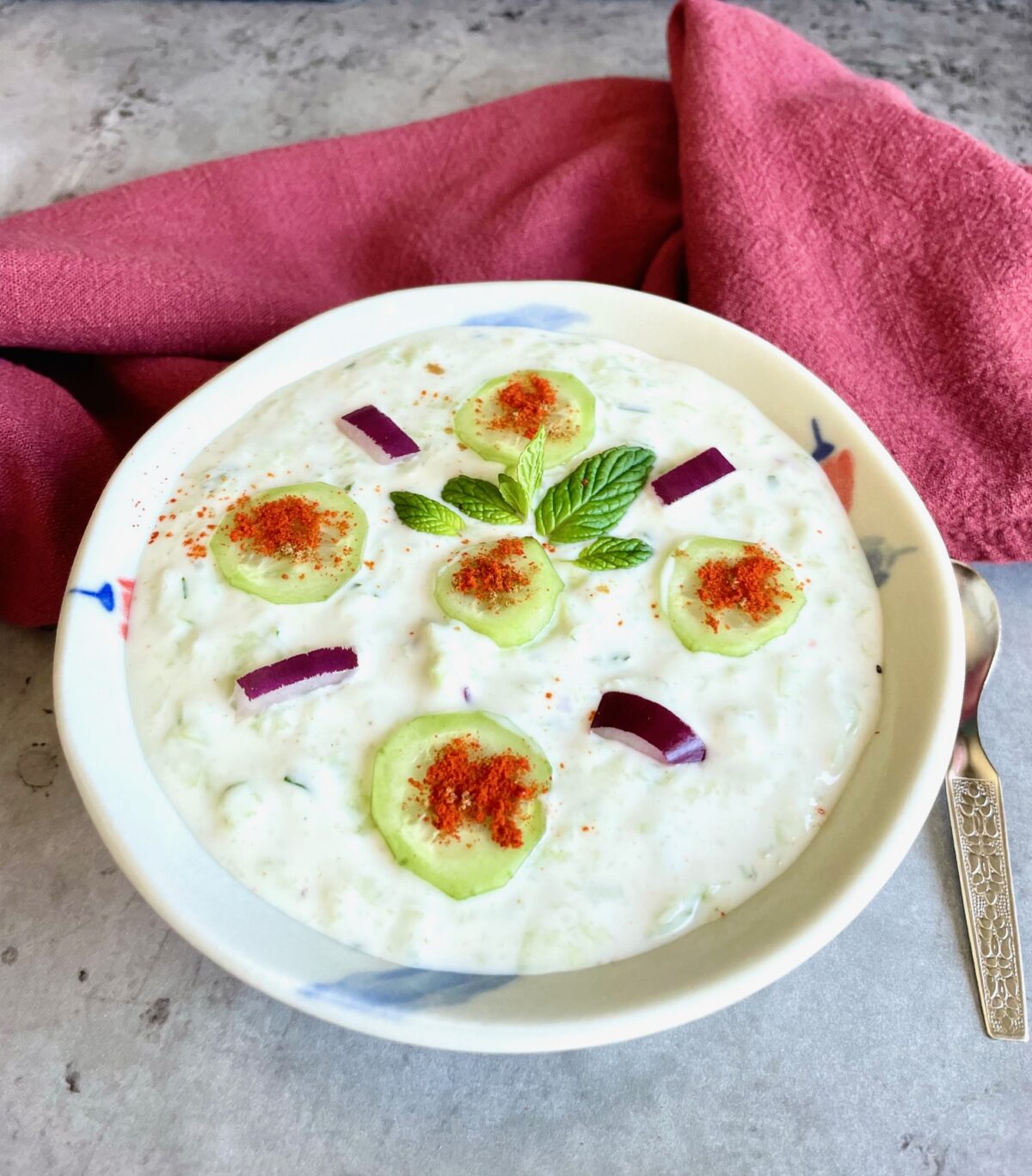
Health benefits of raita
Yogurt
Since the fermentation trend took the United States by storm a few years back, I'm sure you're already familiar with the benefits of fermented foods and drinks. But just in case you missed it, you might be happy to learn that yogurt is not only packed with minerals and vitamins, but it's also teeming with probiotic health benefits! Essential for digestion, the presence of gut-friendly bacteria promotes the good bacteria in your intestine.
When there's an imbalance of good bacteria, you could suffer from digestive and mood issues. So, enjoy the fringe benefits of this tasty condiment to your heart's content, my friends!
Cucumber
Packed with over 50 trace minerals, amino acids like glycine and glutamine, vitamins A and C, and made up of 96% water, cucumbers are incredibly hydrating and do a great job of replenishing your depleted reserves. Although not part of the Dirty Dozen, cucumbers are still oftentimes sprayed with pesticides, so try and source organic cucumbers if you can. If they are unavailable, do not worry. This recipe calls for peeled cucumbers, so you will at least get rid of the outer layer.
Why you'll love this raita recipe
It's a wonderful palate cleanser. This Indian yogurt sauce has a welcoming cooling effect and is the perfect accompaniment to spicy Indian dishes.
Easy and quick recipe.It will be on your table within 10 minutes tops and can even pass for a delicious side dish and not just a humble condiment.
Basic ingredients: Besides optional unusual ingredients like black salt and amchoor powder, your local grocery store should have everything you need to prepare this refreshing Indian yogurt dip.
Makes a great dip for veggies: If you have leftover cucumber raita, you could easily have it with vegetable sticks and turn it into a tasty and healthy snack. Yum!
If you're in for an exotic adventure, you might want to try this cucumber raita with my Mauritian Chicken Biryani, or if you're vegetarian, you can serve it with my delicious Bengali Moong Dal.
Recipe Ingredients
You'll need the following ingredients to make this raita recipe for biryanis (and a lot more!).
- 1 cup yogurt
- 1 large Persian cucumber, peeled and grated (or 2 small Persian cucumbers), about 2/3 cup
- 1-2 teaspoons red onion, minced or diced (some people prefer a lot more onion but this is the amount I'm happy with)
- 1 tablespoon cilantro (fresh coriander leaves), finely chopped
- 2 teaspoon mint, finely chopped
- 1/4 teaspoon cumin powder
- 1/4 teaspoon salt
- Pinch of Kashmiri chili powder, or any red chili powder (optional, or replace with paprika if you don't like spicy)
- Pinch of Indian black salt, or chaat masala (optional)
- Pinch of amchoor powder (optional)
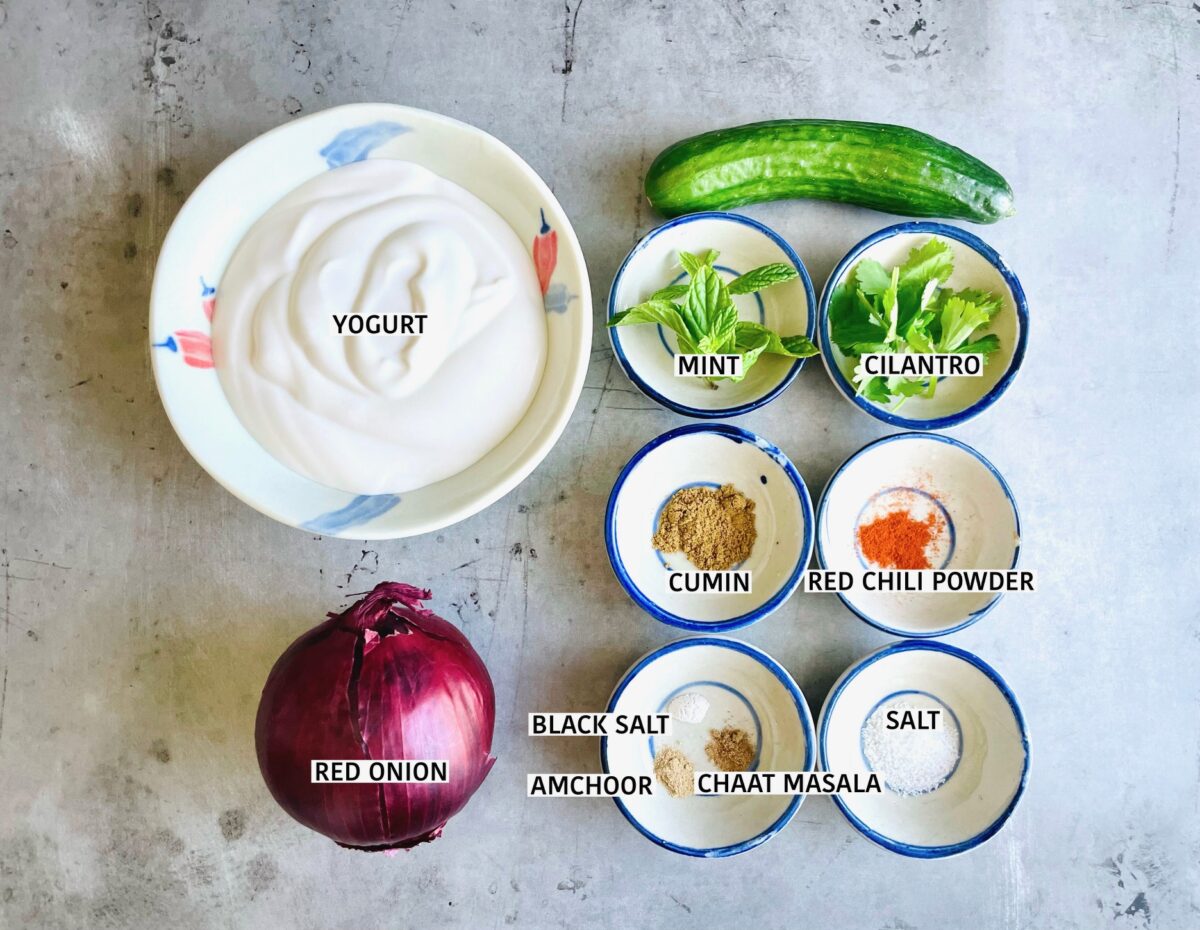
Ingredient Notes
Dairy yogurts
Although this recipe is straightforward, the type of yogurt you pick is very important. Indian yogurt is preferred in this recipe as it has a thinner consistency, is traditional, and a bit more sour than your regular plain yogurt. Greek yogurt won't work as well in a raita recipe, as it is a thick curd, but if that's all you have, you can mix it with either a little water, about 1-2 tablespoons, or extra cucumber, about 1/4 cup, in your raita. Since the cucumber has a high water content, it will release the excess water in your yogurt dip. Whatever you decide to do, try and pick a yogurt without sugar unless you like your raita a little on the sweet side.
Plant-based yogurts
I have tested this recipe with different brands and types of plant-based yogurts, including cashew yogurt and coconut yogurt, but I eventually settled on the Kite Hill almond yogurt because it tastes the closest to dairy yogurt, and let me tell you, I don't miss the real thing!
Indian black salt, chaat masala, and amchoor powder
These ingredients basically do the same thing in this recipe: they add a bit of tang or welcoming funk to your raita, which makes your raita interesting and intriguing. They are by no means essential but I do recommend sourcing these unique Indian spices as they are part of a typical Indian spice kitchen and will elevate your Indian cooking.
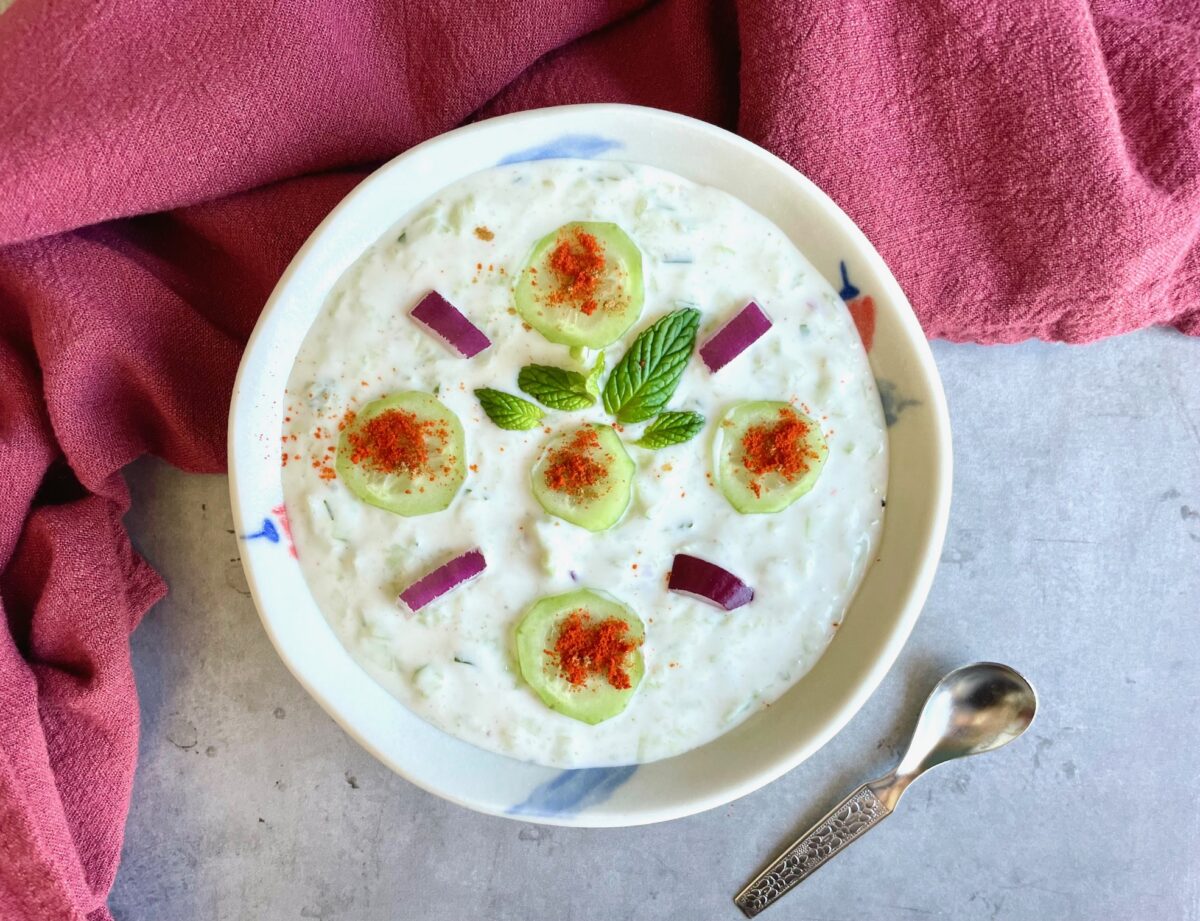
How to make this raita recipe for biryani step by step
- In a medium bowl, whisk yogurt until smooth.
- Add grated cucumber and minced red onion. Mix well.
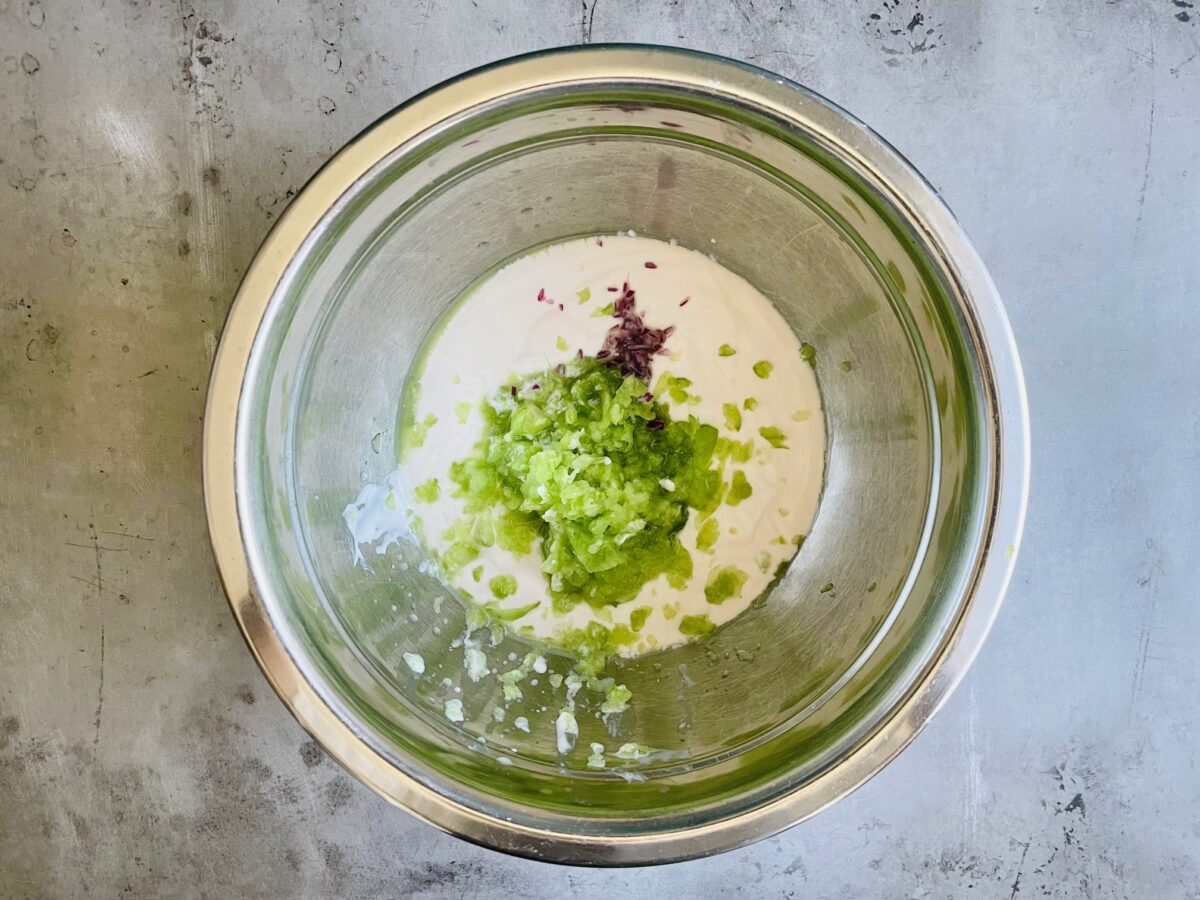
- Next, add the rest of the ingredients: cilantro (fresh coriander), mint, cumin powder, Kashmiri chili powder or red chili powder, Indian black salt or chaat masala, amchoor, and salt. Give it a good stir to mix all the ingredients well.
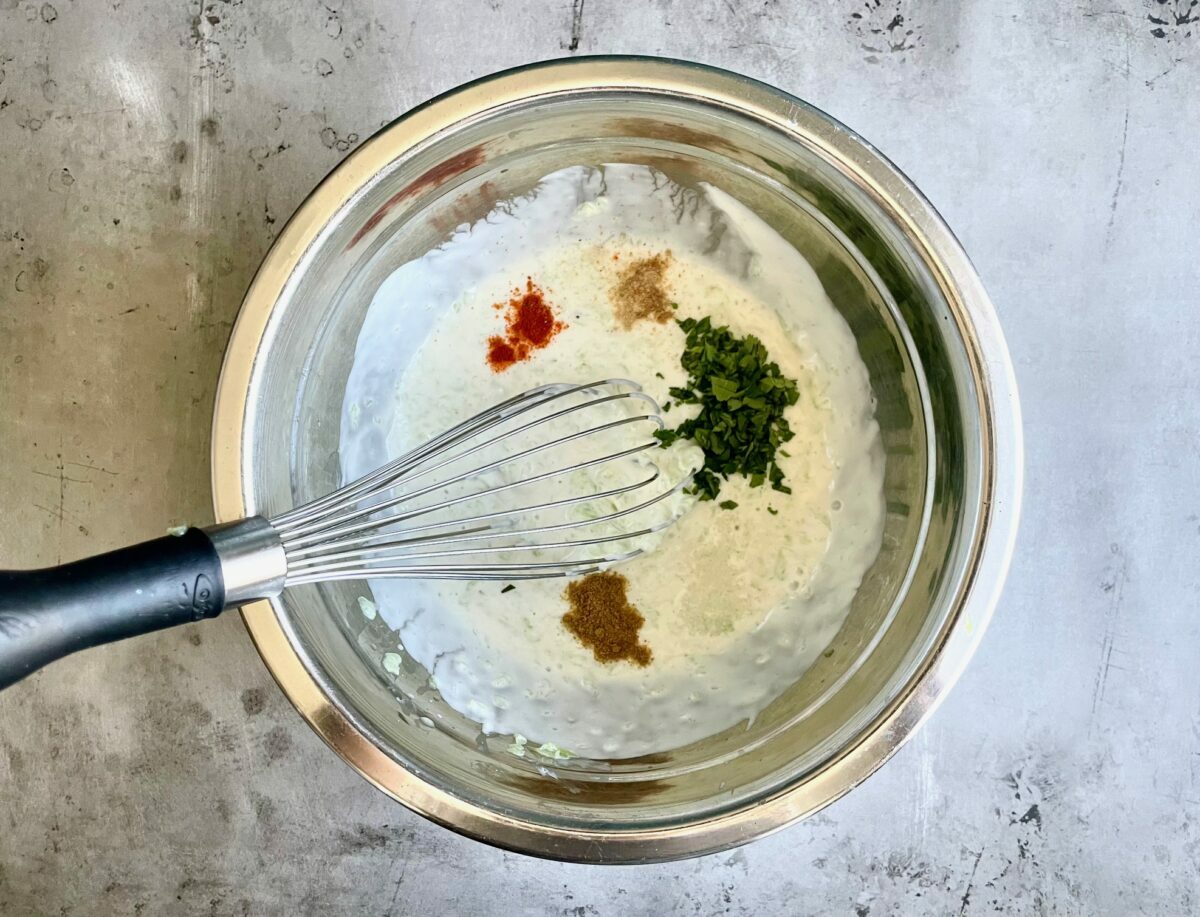
- Taste and adjust the salt and spices to your liking. Please note that this yogurt dip is usually undersalted. So, avoid adding too much salt.
- Garnish with additional fresh cilantro, mint leaves, and a little Kashmiri chili powder for color.
- Serve with your biryanis, Indian curries, or pulaos.
Frequently Asked Questions (FAQs)
Some types of raitas can last 1-2 days in the fridge, but cucumber raitas, like this one, are best served fresh and chilled as the cucumber will release water and the herbs can get soggy. Generally, I don't recommend keeping leftover raita but 12 hours in the fridge is acceptable.
Raita does not freeze well. Just make a fresh batch every time.
This raita is not spicy, and if you would like to take the spice level up a notch, I recommend adding some green bird's eye chili (aka Thai chilis) or jalapenos. Although I love spicy food, I like to keep my raita mild since I normally serve it with spicy Indian dishes, and its job is to put out the fire!
I wouldn't normally recommend using low-fat yogurt as it is not traditional, but neither is the plant-based yogurt in this recipe. So if you much prefer low-fat yogurt, go for it!
Although they both use the same base ingredients: yogurt and cucumbers, they do have some distinct differences. Indian raita uses dahi, which has a thin consistency and is made from cow milk, whereas Greek tzatziki uses a thick yogurt made of strained sheep or goat yogurt.
They can both contain mint, but raita can also contain cilantro and not dill, and tzatziki can also contain dill and not cilantro. The spices also differ. Naturally, raita is seasoned with Indian spices, whereas tzatziki is flavored with fresh lemon and garlic. They are both delicious in their own way!
Sourcing unusual ingredients
Indian Black salt or Kala Namak

Easy Everyday Raita Recipe for Biryani (Without Sugar)
Ingredients
- 1 cup full-fat yogurt I used Kite Hill almond yogurt but you can use plain sugar-free yogurt.
- 1 large Persian cucumber peeled and grated, about ⅔ cup grated
- 1-2 teaspoons red onion minced or diced (you can use more)
- 1 tablespoon cilantro (fresh coriander leaves) finely chopped
- 2 teaspoon mint finely chopped
- ¼ teaspoon cumin powder
- Pinch Kashmiri chili powder or any red chili powder (optional, or replace with paprika if you don't like spicy)
- Pinch Indian black salt or chaat masala (optional)
- Pinch amchoor powder green mango powder (optional)
- ¼ teaspoon salt or per taste
Instructions
- In a medium bowl, whisk yogurt until smooth.
- Add grated cucumber and minced red onion, and mix well.
- Next, add the rest of the ingredients: cilantro, mint, cumin powder, salt, Kashmiri chili powder or red chili powder, Indian black salt or chaat masala, and amchoor. Give it a good stir to mix all the ingredients well.
- Taste and adjust the salt and spices to your liking. Please note that this yogurt dip is usually undersalted. So, avoid adding too much salt.
- Garnish with additional fresh cilantro, mint leaves, and a little Kashmiri chili powder for color. Serve with biryani or your favorite Indian dish. Serve immediately.


Leave a Reply